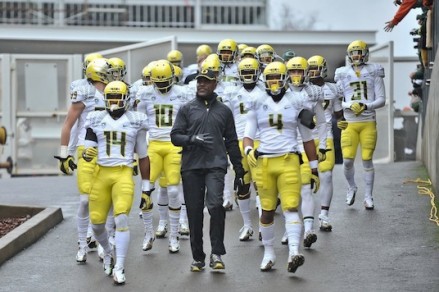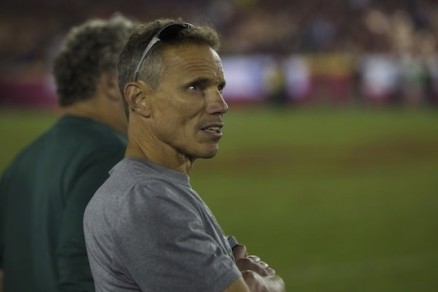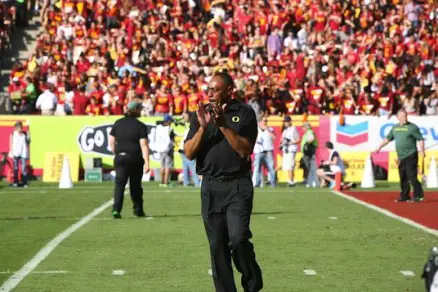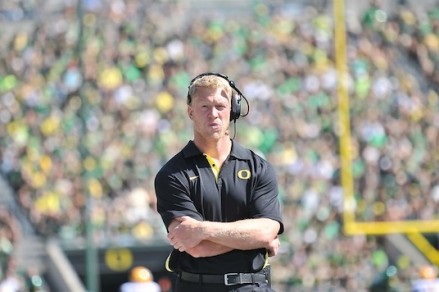Under the new regime, one can only hope that the logistical challenges of recruiting are met head on with an efficient and effective strategy. What follows is a look into the logistics involved with my “ideal recruiting blueprint.”
It’s easy to forget that recruiting takes time and that the best recruiters are tireless workers. Scheduling a time to talk, organizing notes and preparing for the conversation are all part of contacting a recruit. Meanwhile, the conversations themselves can take a significant amount of time. So what’s reasonable? What’s necessary? How much time should coaches spend recruiting?
First, it’s important to note that there are four major recruiting phases:
1) Evaluations (February – July)
2) Off-Season (March – July)
3) In-Season (August – December)
4) Closing (January)
Phases 1 and 2 obviously bleed into each other, and that complicates things. For the purposes of this article, we’re going to focus on phases 2 and 3, the bulk of the recruiting cycle (March-December).
Phase 1 speaks to the ongoing process of player evaluations, which take up resources (time) that shouldn’t be overlooked, but will not be the focus of this article. Most fans already understand that as part of their jobs, coaches sit down and evaluate a ton of film to decide who is and who is not worth pursuing, along with traveling around the country to evaluate different prospects in person. In general, evaluations last through the summer camp circuit.
Phase 4 involves the final month before National Signing Day, which is incredibly variable depending on what happened during phases 2 and 3. If your class is already full, January is going to look a lot different than it would if you needed to fill ten spots, like Oregon did this last January. Thus, it’s too difficult to create a general blueprint for something that is so variable.
Phases 2 and 3 each present a different set of obstacles when it comes to finding time to recruit. During phase 2 coaches are evaluating prospects, preparing for the following year and most notably, coaching spring football, which includes not only the practices themselves, but also preparing for the practices, team/player meetings, film review and post-spring evaluations among other things. Meanwhile, phase 3 occurs during the football season; it’s not hard to see how busy a college coach could be during the fall.
So where does this leave recruiting? Coaches are obviously busy during a large majority of the year, yet it’s been proven time and again that building relationships with recruits is critical to ultimately landing commitments. What’s the solution? Well, put plainly: coaches need to work their tails off.
As discussed in Part 2 of this recruiting blueprint, it’s important to build relationships with a large number of prospects. These relationships require constant care. Overdoing it isn’t necessary, either. I see a happy medium of “once-per-week” contact between primary recruiter and recruit. If a prospect is being contacted weekly, then he knows he’s valued by the program and gets a real opportunity to forge a bond with his recruiter. If said recruit chooses to go elsewhere, it’s not due to a lack of effort on the part of the coaching staff. Any recruit who needs to be contacted daily in order to know where he stands probably wouldn’t fit into Oregon’s culture, anyway. Once-per-week is plenty.
So, we’ve established that once-per-week contact is optimal. Note that this is between primary recruiter and recruit. Different programs recruit differently, but it’s my belief that the player’s eventual position coach should act as the primary recruiter (as opposed to having different coaches recruit different geographic regions of the country). Now, with Oregon in particular, it’s not always known where a prospect will end up, but the coaches usually have a pretty good idea of where a player will end up fitting best. That position coach should take the lead.
Here is list of Oregon’s position coaches, the guys tasked with being the primary recruiters for Oregon:
QB – Scott Frost
RB – Gary Campbell
WR – Matt Lubick
TE – Tom Osborne
OL – Steve Greatwood
DL – Ron Aiken
LB – Don Pellum
DB – John Neal
Next, let’s look at a typical breakdown of commitments by position during a “general” year. This example will use a “full class” of 24 players for simplicity’s sake:
QB: 2
RB: 2
WR: 2
TE: 2
OL: 4
DL:4
LB: 4
DB: 4
= 24 Commits
Finally, in order to look at how much time each position coach should spend “recruiting”, let’s assume a 25% success rate. This means that for every four players recruited, one will end up committing to Oregon (this doesn’t necessarily mean 25% of players offered, but 25% of players who the coaches spend resources pursuing). Thus, in order to fill two QB spots, eight players would need to be pursued. Here’s a breakdown of the number of players at each position that the coaches should pursue using the “full class” example:
QB: 8
RB: 8
WR: 8
TE: 8
OL: 16
DL: 16
LB: 16
DB: 16
= 96 Prospects
96 players? On the surface, it doesn’t seem possible to build relationships with 96 prospects, which is exactly what this blueprint is asking the Oregon coaches to do (in a general sense, using a “full class” year as the example). How is it possible to contact 96 recruits weekly? Well, let’s assume that each “contact” takes 30 minutes. That 30 minutes includes scheduling a time to talk and preparing for the conversation (whatever this might entail) in addition to the conversation itself. Based on the number of prospects that we’ve deemed necessary to contact at each position, here’s how much time each position coach would spend recruiting in a given week:
QB Coach Scott Frost – 4 Hours
RB Coach Gary Campbell – 4 Hours
WR Coach Matt Lubick – 4 Hours
TE Coach Tom Osborne – 4 Hours
OL Coach Steve Greatwood – 8 Hours
DL Coach Ron Aiken – 8 Hours
LB Coach Don Pellum – 8 Hours
DB Coach John Neal – 8 Hours
Not only does that seem possible, it appears that each coach could spend even more time elsewhere. Given the importance of recruiting, and how influential it is to on-field success, it seems reasonable to ask that each position coach spend 10 hours per week recruiting (not including player evaluations). Here’s how much additional time each coach would have each week to build stronger relationships, accomplish administrative tasks and help out fellow coaches:
Frost: 6 Hours
Campbell: 6 Hours
Lubick: 6 Hours
Osborne: 6 Hours
Greatwood: 2 Hours
Aiken: 2 Hours
Pellum: 2 Hours
Neal: 2 Hours
That’s 32 ADDITONAL hours per week. That doesn’t even factor in the time spent recruiting by head coach Mark Helfrich and defensive coordinator Nick Allioti, who, along with offensive coordinator Scott Frost, could focus their attention on high-priority targets.
So there it is. 10 hours per week paves the way to 96 relationships. That doesn’t mean 96 offers, but it does mean ensuring that when top targets go elsewhere, good backup options are waiting in the wings. Remember that this covers a time period from March through December, and also keep in mind that as Oregon targets start committing to other programs, resources should be spent elsewhere. As March becomes September (as the season begins), 96 targets may become 48. Things begin to seem much more manageable when you see that the bulk of the work comes during the quiet period between spring football and the beginning of the season. That said, in-season (during phase 3), coaches should be making an aggressive push for their favorite targets, in addition to fulfilling their normal coaching responsibilities, meaning long hours.
Given the importance of recruiting and based on observations already mentioned throughout the first 7 parts of this recruiting manifesto, building a large number of relationships is critical to an effective recruiting strategy. There’s nothing wrong with casting a wide net since pursuing a relationship doesn’t mean proposing. “Casting a wide net” is logistically possible if each Oregon coach spends 10 hours each week recruiting, particularly during “phase 2.”
Regardless of other responsibilities and not including the time it takes to evaluate prospects, this blueprint suggests that all Oregon coaches find a way to recruit for 10 hours every week, from March through December, while acknowledging that those hours will be spent differently as summer transitions into fall.
Next week, the blueprint will wrap up by looking at other logistical factors that need to be considered as a part of any recruiting strategy.
Related Articles:
Chip Kelly Update: Everything's Good Again ...
Chip Kelly Update: Wailing and Gnashing of Teeth
Shock and Awe -- The Oregon Ducks' Football Hangover Effect
Despite Lopsided Score, Georgia State "Never Stopped Believing"
Hope Springs Eternal for Ducks
Incompetent Pac-12 Officials: How Do You Miss ALL of THIS?
Chris was born in Montevideo, Uruguay, but made his way to Oregon by the age of five, when he attended his first game at Autzen Stadium. A huge sports fan at a young age, Chris grew up playing football, basketball and golf. Although realizing he isn’t likely to play in the NFL or NBA, Chris still holds on to hopes of being a professional golfer should his unfortunate putting woes take a turn for the better. A bit of a platypus, he attended both Oregon State and Oregon during his collegiate days where he earned a business degree in Finance and Business Administration. Chris works for Daimler Trucks North America in Portland, and plans to get his MBA from the University of Oregon.
Chris has been an active member in the recruiting community since 2005. He studies the intricacies of recruiting and is particularly intrigued by talent evaluation techniques. He is currently working on developing his own scouting reports for every scholarship player on the UO roster. Chris lives with his wife, Katrina, and his two-year-old son Lucas (a future dual-threat QB).





